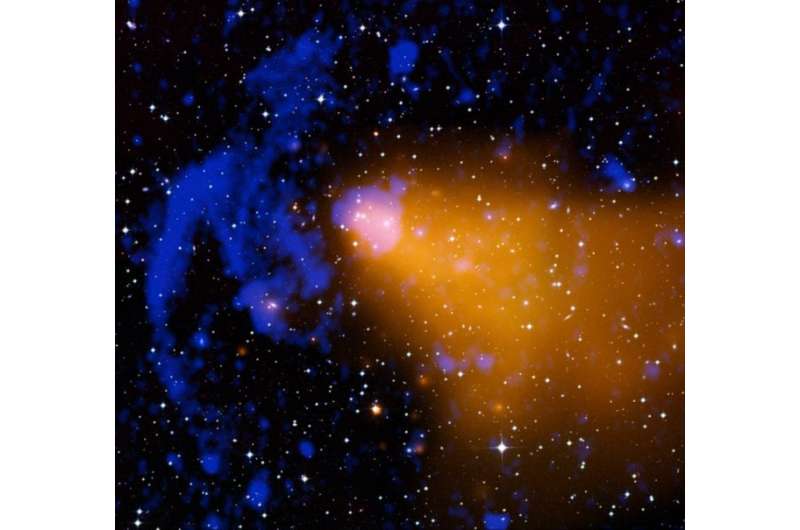July 2, 2018 report
Astronomers study the merging galaxy cluster Abell 3376 and its radio relics

Using the Suzaku space telescope, astronomers have conducted an X-ray spectral study of the nearby merging galaxy cluster Abell 3376 and its two arc-shaped radio relics. The new research reveals more insights into the properties of the radio sources in this cluster. The findings are presented in a paper published June 20 on arXiv.org.
Abell 3376 is a nearby bright and moderately massive merging galaxy cluster. It has two giant arc-shaped radio relics in its outskirts. Radio relics are diffuse, elongated radio sources of synchrotron origin, occurring usually in the form of spectacular single or double symmetric arcs at the peripheries of galaxy clusters.
Merging galaxy clusters like Abell 3376 are excellent places to search for radio relics and study them, as such sources originate in acceleration and re-acceleration at merger shocks. However, given that the number of known radio relics associated with merger shocks is still small, astronomers are interested in more detailed studies of those sources already identified in merging systems.
Abell 3376 with its radio sources has been a subject of a recent study conducted by a team of researchers led by Igone Urdampilleta of the SRON Netherlands Institute for Space Research in Utrecht, The Netherlands. They analyzed observational data collected by the X-ray Imaging Spectrometer (XIS) onboard NASA/JAXA Suzaku astronomy satellite, complemented by archival data provided by ESA's XMM-Newton space telescope and NASA's Chandra X-ray observatory.
The analysis uncovered more details regarding the properties of Abell 3376's radio relics and could contribute to better understanding of the process of galaxy merging.
"We present an X-ray spectral analysis of the nearby double radio relic merging cluster Abell 3376 (z = 0.046), observed with the Suzaku XIS instrument. These deep (~360 ks) observations cover the entire double relic region in the outskirts of the cluster," the astronomers wrote in the paper.
As a result of the analysis, the researchers confirmed that Abell 3376 exhibits a stronger merger shock in the western direction (coincident with the radio relic in the West), a weaker shock in the East (possibly associated to the "notch" of eastern relic), and a cold front. The velocities of the western and eastern shocks were calculated to be about 1,630 and 1,450 km/s respectively.
When it comes to the cold front, the astronomers found that it is located approximately 490,000 light years from the X-ray emission peak at the center and delimits a cool gas cloud moving with a velocity of approximately 1,300 km/s.
Furthermore, assuming that the shock fronts are moving with constant velocity, Urdampilleta's team found that the time since core passage is about 600 million years, which is in good agreement with previous simulations and with earlier multiwavelength analyses. The authors of the paper emphasize that their results confirm that Abell 3376 is still an evolving merging cluster.
"Based on the shock speed calculated from the Mach numbers, we estimate that the dynamical age of the shock front is ~0.6 Gyr after core passage, indicating that Abell 3376 is still an evolving merging cluster and that the merger is taking place close to the plane of the sky," the scientists concluded.
More information: X-ray study of the double radio relic Abell 3376 with Suzaku, arXiv:1806.07817 [astro-ph.GA] arxiv.org/abs/1806.07817
Abstract
We present an X-ray spectral analysis of the nearby double radio relic merging cluster Abell 3376 (z = 0.046), observed with the Suzaku XIS instrument. These deep (∼360 ks) observations cover the entire double relic region in the outskirts of the cluster. These diffuse radio structures are amongst the largest and arc-shaped relics observed in combination with large-scale X-ray shocks in a merging cluster. We confirm the presence of a stronger shock (MW = 2.8 ± 0.4) in the western direction at r∼26', derived from a temperature and surface brightness discontinuity across the radio relic. In the East, we detect a weaker shock (ME = 1.5 ± 0.1) at r∼8', possibly associated to the 'notch' of eastern relic, and a cold front at r∼3'. Based on the shock speed calculated from the Mach numbers, we estimate that the dynamical age of the shock front is ∼0.6 Gyr after core passage, indicating that Abell 3376 is still an evolving merging cluster and that the merger is taking place close to the plane of the sky. These results are consistent with simulations and optical and weak lensing studies from the literature.
© 2018 Phys.org





















